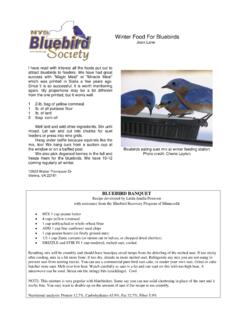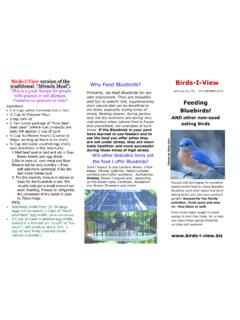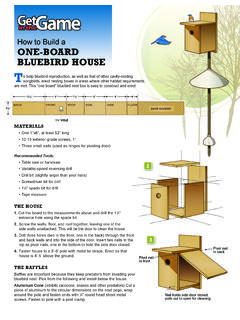Transcription of BLUEBIRD LIFE CYCLE CONSERVATION - Virginia Bluebird …
1 BLUEBIRD CONSERVATION In the early 1900 s the Eastern BLUEBIRD was one of Virginia s most common songbirds. Human activities and several harsh winters resulted in a severe decline of the BLUEBIRD population. Thanks to CONSERVATION efforts, such as establishing and maintaining BB trails, the BLUEBIRD is making a strong comeback. However, the continuing loss of natural nesting sites and other problems faced by bluebirds indicate that this beloved bird may always need help to survive. REASONS FOR DECLINE Sprawl - cities have spread into rural areas reducing preferred habitat. Dead trees Snags are removed by homeowners. This reduces nesting sites for primary cavity nesters (woodpeckers). Bluebirds, chickadees, tree swallows and house wrens are all secondary cavity nesters.
2 These birds nest in the holes in trees made by woodpeckers. The introduction of the starling and house sparrow to North America resulted in a loss of available nest sites for bluebirds. These non-native species are so adaptable and aggressive that they spread across the continent taking nesting cavities, killing our native birds and destroying their eggs. Many small farms have been combined into large operations with huge fields that destroy the mixed habitat needed by native cavity nesters. Winter food supply has declined with suburban sprawl and the increase of lawns over gardens, and native vegetation is reduced. The few wild berries that remain are often stripped quickly by large flocks of starlings. Pesticides and herbicides can be lethal for birds. Pesticides kill the food supply (insects) and the toxins from the pesticides also build up in the birds as they ingest the insects.
3 Contact with herbicides (such as glyphosate) can kill bluebirds very quickly. life CYCLE The eastern BLUEBIRD belongs to the Thrush family. The male is brilliant blue with a rusty breast and throat. The female is gray blue with a buff breast. Their diet consists of mostly insects in the summer and wild berries when insects are not available. The fledglings have spotted feathers until the fall molt when all bluebirds grow dull feathers for protection from predators. The males are bright blue again by spring. As early as March, or late as June, the male BLUEBIRD locates a nesting site, establishes a territory around it, and sings to attract a female and warn other male bluebirds to stay away. Once a female accepts the male and the nest site, she builds a neat cup nest of dry grass or pine needles. Nest building can take five days to three weeks, depending on weather and time of year.
4 The female lays one blue or, occasionally, white egg, each morning, until three to six are produced. She does not incubate the eggs until all are laid. Incubation takes 12 to 14 days. All the chicks hatch within hours of each other. The adults feed the nestlings with soft insects and caterpillars, graduating to larger ones as the nestlings grow. The parents keep the nest clean by removing the fecal sacs, which enclose the nestling s waste. The young grow rapidly. By the eighth day their eyes are open, and their feathers are beginning to unsheath. They have a white eye ring by the 12th day. At 18 to 21 days after hatching, the nestlings fledge, (leave the box). All the chicks usually leave the box within a period of two or three hours. The fledglings can flutter 50 to 100 feet on their first flight.
5 They try to land in a bush, shrub or low branches of trees to be off the ground and away from predators. The parents continue to care for the young, teaching them to hunt for insects. The male will carry on this job while the female begins the 2nd nest. After the nesting season is over, bluebirds give up their territories and flock together. In Virginia , blue birds often do not migrate, but are joined by migrant northern bluebirds and roam looking for berries in mixed flocks. The northern migrants usually move farther south after October. Bluebirds roost in stands of pine trees, tree cavities, and trail boxes during cold weather. As many as 10 or more may roost in the same cavity in order to share body warmth. NESTING SCHEDULE Mid February Male BLUEBIRD selects territory March - Female BLUEBIRD selects mate April - First nest building, egg laying Mid April Mid May - First brood June 1 July 25 - Second brood (and possible third) NEST BOXES A BLUEBIRD trail is a series of five or more nest boxes placed along a prescribed route.
6 BLUEBIRD populations are increasing in areas where nestboxes have been placed in suitable habitat. NEST BOX DESIGN There is no perfect BLUEBIRD box design, but basic principals must be followed. A good BLUEBIRD nestbox should: Be well ventilated ( Virginia summers can be very hot), Be watertight, and have drainage holes. Not be made from treated lumber due to toxicity. Can be painted or stained if a light color is used (do not paint or stain the interior of the box). Include at least one panel (front or side) that opens for easy monitoring and cleaning. Never have a perch. Sparrows and wrens are attracted to perches and perches also enable larger birds to predate the nest. Have a hole 1-1/2 in diameter (this hole size excludes starlings). Floor size of the box approximately 4x4 or 5x5 Please see our website for an easy-to-make nest box design MOUNTING & PLACEMENT Habitat is the key factor to consider when setting up a BB trail.
7 Select an open area with scattered trees and low ground cover. Suitable habitat should also include perch sites, such as fence lines, overhead wire, or tree branches, where the bluebirds can alight to search for food and guard their nests. Pastures, parks, golf courses, meadows, and cemeteries are ideal places for a BLUEBIRD trail: shun areas where pesticides are used. Avoid locations that are brushy or heavily wooded. The house wren, a native cavity nester that competes with the BLUEBIRD for nesting sites, prefers these habitats. Avoid areas that are dominated by house sparrows, such as farmyards, feedlots and urban centers. Nest boxes should be spaced at least 100 yards apart. In areas where tree swallows are present, many bluebirders pair their boxes. By placing two boxes close together (5 to 25 feet apart) both species will usually nest together peaceably.
8 Boxes should be mounted on a pole (never on a tree), 4 to 5 feet above the ground, facing a shrub or tree with low branches (for fledgling s maiden flight). Face the box toward the east or northeast with the entrance hole pointing away from the prevailing wind. Nest boxes should be in place by the end of February, or even earlier if possible. Predator guards should be used on every pole to protect the nestbox. Stovepipe baffles work best: and prevent snakes, raccoons, squirrels, and mice from accessing the box. (See our website for plans) MONITORING Do not put up a BLUEBIRD box if you do not plan to monitor it. Many people are hesitant about looking into a nestbox, but supervising your boxes can give the BLUEBIRD a much greater chance of survival. Monitoring leads to the early detection of problems and provides valuable research data.
9 Don t be discouraged if your nestbox is not used the first year; it may take the birds a while to find it. Boxes should be monitored weekly during the nesting season. Only remove house sparrow nests; leave the nests of other native cavity nesters. (Federal law prohibits destroying or tampering with a nest of any native species). MONITORING TIPS Monitor once a week in spring and summer. Try to monitor at the same time every week to be consistent with your data Monitor only during warm, dry weather to prevent chicks from being chilled (the chicks are most vulnerable to cold in the first 8 days of life before they are fully feathered). During these first few critical days, open the box for only a brief time. Talk quietly as you approach the box in order to alert the birds inside. Stand away from the entrance hole and open the box slowly, counting the number of eggs and nestlings and note the age of the nestlings.
10 Check for parasites in and around the nest box. Record your findings. At end of season - data is collected by VBS. The forms are on the website. Ensure box is closed securely when you leave. Do not open the nestbox after the nestlings are 12 days or older. This may cause them to fledge early before they are able to fly. After the chicks fledge, remove the old nest and carry the nesting material away from the nestbox NEST IDENTIFICATION BLUEBIRD Cup shaped, fine grass or pine needles. Eggs are blue (sometimes white). Chickadee Made of moss, grass and animal hair. Eggs are very small, creamy with brown speckles Wren Nest of twigs with a cup of fine grass inside. Eggs are very small, dark brown and speckled. Tree Swallow Fine grass nest with feathers. Eggs are small, oval and white. House sparrow Box full of grass, feathers and trash.











